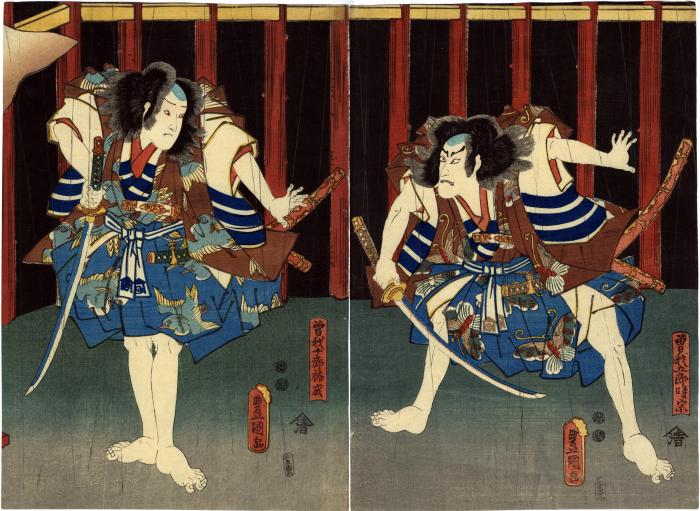Utagawa Kunisada (歌川国貞) / Toyokuni III (三代豊国) (artist 1786 – 01/12/1865)
Ichikawa Danjūrō VIII (八代目市川団十郎) as Soga Goro Takimune (曽我五郎時宗) on the right and Ichimura Takenojō V as Soga Juro Sukenari (曽我十郎祐成) on the left - the center and right panels of a triptych
05/07/1851
19 in x 14.125 in (Overall dimensions) Japanese woodblock print
Signed: Toyokuni ga (豊国画)
Publisher: Shimizuya Naojirō
(Marks 468 - seal 01-081)
Censor seals: Mera and Watanabe
Seal: Shita-uri
Waseda University - left panel
Waseda University - right panel
Museum für angewandte Kunst, Vienna - right panel
Museum für angewandte Kunst, Vienna - left panel
Tokyo Metropolitan Library - presented as a triptych
Victoria and Albert Museum - the whole triptych
Waseda University - the far left missing panel
Östasiatiska Museet, Stockholm - right-hand panel
Östasiatiska Museet, Stockholm - left-hand panel These two panels - the center and right - of a triptych made to commemorate a performance of the play Hōraizan Yatsugi Soga (蓬莱山...曽我) at the Ichimuri-za in 1/1851. So far we know absolutely nothing about this specific play other than its title and when it was staged. We found the title at the Victoria and Albert web site.
****
Samuel L. Leiter noted of the Soga genre that "No other subject has been so frequently dramatized in Japan, there being something like three hundred Soga plays in kabuki alone."
Later Leiter added: "Soga plays proliferated in Edo during the first decade of the 1700s and by the 1730s the custom was established at each of the Edo sanza for the New Year's program (hatsuharu kyōgen) to include a Soga mono because of the auspiciousness. Earlier, the story had been a traditional feature of hte summer performances in Kamigata centering on the bon festival in honor of the dead, but this custom died out in the mid-eighteenth century, whereas the New Year's tradition was maintained in Tokyo until the first decade of the twentieth century."
Source and quotes from: New Kabuki Encyclopedia..., Samuel L. Leiter, pp. 608 and 609.
****
The term shita-uri as a special meaning according to Sarah Thompson in Undercurrents in the Floating World: Censorship and Japanese Prints in describing a multi-panel composition on pages 52-53: "A further concession to the reform laws, the print bears a special seal on each sheet reading shitauri, or "selling below," indicating that it could be sold only from the counter and not hung up for display at the front of the store."
Shimizuya Naojirō (清水屋直次郎) (publisher)
actor prints (yakusha-e - 役者絵) (genre)
Ichikawa Danjūrō VIII (八代目市川団十郎: 3/1832 - 6/8/1854) (actor)
Ichimura Takenojō V (五代目市村竹之丞: from1/1851 to 8/1851) (actor)
Soga brothers (曾我兄弟) (genre)
